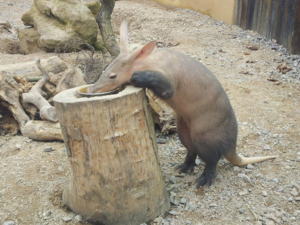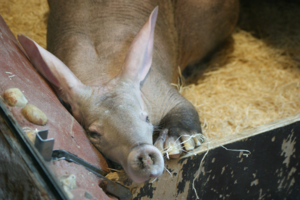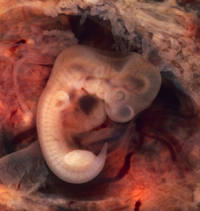Difference between revisions of "Aardvark"
(→Lifecyle of an Aardvark) |
m (→Lifecyle of an Aardvark: Subheading read 'lifecyle' not 'lifecycle') |
||
| Line 37: | Line 37: | ||
|} | |} | ||
| − | === | + | ===Lifecycle of an Aardvark=== |
{| class="wikitable" | {| class="wikitable" | ||
|'''Foetus''' | |'''Foetus''' | ||
Latest revision as of 14:34, 12 August 2019
Key Stage 1
Meaning

A drawing of an aardvark.
An aardvark is a medium-sized animal with 4 legs and a long pig-like snout.
About Aardvarks
- The nose and the mouth of an aardvark are at the end of its snout.
- The aardvark is nocturnal, which means it will only come out at night.
Examples
| This is a picture of an aardvark eating. | This is a picture of an aardvark's snout. |
Key Stage 2
Meaning
An aardvark is a medium-sized, burrowing mammal with 4 legs and a long pig-like snout.
About Aardvarks
- As a mammal aardvarks:
- Aardvarks live in Africa, and are found in bushland, woodland, grassland and savanna habitat.
- The aardvark is nocturnal, which means it will only come out at night.
- Aardvarks dig and live in burrows.
- A young aardvark is called a cub.
| An aardvark's skeleton showing its backbone. |
Lifecycle of an Aardvark
| Foetus | Young | Adult |
| An aardvark starts its life inside the mother getting its food through the umbilical cord. | When an aardvark has been born it cannot eat so it gets milk from its mother to survive. This is a young aardvark cub. | An adult aardvark is mature and can have it's own offspring. |
Adaptations of Aardvarks
| Adaptation | Purpose |
| A pig-like snout | To help the aardvark sniff out its food: ants and termites. |
| Sharp claws | To dig up ants and termites for food, and so it can dig burrows to live and sleep in. |
| Powerful legs | To help with digging up food and burrowing. |
| Long, sticky tongue | To help capture insects. |
Key Stage 3
Meaning
An aardvark is a medium-sized, burrowing mammal with 4 legs and a long pig-like snout.
About Aardvarks
- As a mammal aardvarks:
- Are vertebrates
- Feed their offspring with milk.
- Give birth to live young.
- Keep a constant internal temperature.
Adaptations of Aardvarks
| Adaptation | Purpose |
| A pig-like snout | To help the aardvark sniff out its food: ants and termites. |
| Sharp claws and powerful legs | To dig up ants and termites for food, and so it can dig burrows to live and sleep in. |
| Thick nostril hair | To help filter through matter and search for food as it digs. |
| Muscular area in stomach | To break down food, rendering chewing unnecessary, as an Aardvark has only a few teeth and no enamel. |
| Long, sticky tongue | To help capture insects. |
Key Stage 4
Meaning
An aardvark is a medium-sized, burrowing animal with 4 legs and a long pig-like snout, in the class; mammal.
About Aardvarks
- As a mammal aardvarks:
- Are vertebrates
- Feed their offspring with milk.
- Are viviparous.
- Are homeotherms.
Adaptations of Aardvarks
| Adaptation | Purpose |
| A pig-like snout | To help the aardvark sniff out its food: ants and termites. |
| Sharp claws and powerful legs | To dig up ants and termites for food, and so it can dig burrows to live and sleep in. |
| Thick nostril hair | To help filter through matter and search for food as it digs. |
| Muscular pyloric area in stomach | To break down food, rendering chewing unnecessary, as an Aardvark has only a few teeth and no enamel. |
| Long, sticky tongue | To help capture insects. |





